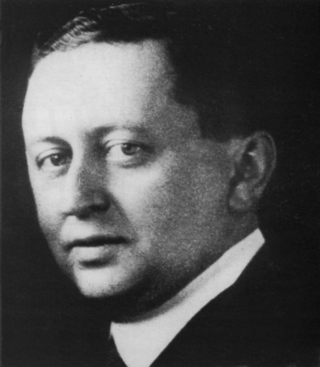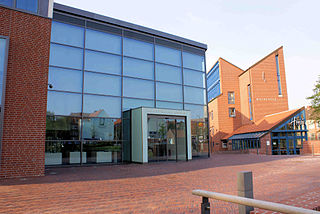Related Research Articles

The Kunsthistorisches Museum is an art museum in Vienna, Austria. Housed in its festive palatial building on the Vienna Ring Road, it is crowned with an octagonal dome. The term Kunsthistorisches Museum applies to both the institution and the main building. It is the largest art museum in the country and one of the most important museums worldwide.

Palais Rothschild refers to a number of palaces in Vienna, Austria, which were owned by members of the Austrian branch of the Rothschild banking family. Apart from their sheer size and elegance, they were famous for the huge collections of valuable paintings, statues, furniture, books and armour that they housed, another reflection of the family's vast wealth and prominent position.

Jakob Goldschmidt was a German-Jewish banker.
Hermann Jacob Eissler was an Austrian entrepreneur and art collector persecuted and plundered by Nazis because of his Jewish origins.

August Lederer, was an Austrian industrialist and art collector whose art collection was looted by Nazis. He helped promote the artists of the Vienna Secession, notably Gustav Klimt.
Rosa Oppenheimer was a German Jewish art dealer who was murdered in the Holocaust. The art she owned together with her husband Jacob is the subject of several high-profile restitution claims.

The art collection of Ismar Littmann (1878–1934), a German lawyer who lived in Breslau, comprised 347 paintings and watercolors and 5,814 drawings from artists such as Lovis Corinth, Max Pechstein, Erich Heckel, Max Liebermann, Käthe Kollwitz, Lucien Adrion, and Otto Mueller.

Kunsthalle Emden is a German art museum in Emden in East Frisia, Germany.

Julius Freund was a German entrepreneur and art collector persecuted by the Nazis because he was Jewish.

Curt Glaser was a German Jewish art historian, art critic and collector who was persecuted by the Nazis.

Walter Westfeld or Westfield was a German Jewish art collector and art dealer whose collection was plundered by Nazis. Westfield was murdered in the Holocaust.
Lea Bondi, later Lea Jaray or Lea Bondi-Jaray was an Austrian art dealer and art collector who was forced to emigrate to Great Britain due to Nazi persecution after the annexation of Austria to the Nazi German Reich. The Würthle Gallery, which she ran, was "Aryanized" by Nazis and her art collection, including the Portrait of Wally by Egon Schiele, extorted.
Franz Kieslinger was an Austrian art historian and art dealer, who was a Nazi and involved in art theft during the Nazi era.
Frederic ("Fritz") Wolff-Knize was a German businessman, owner of Kniže & Comp. and an art collector.
Leopold Weinstein was an Austrian businessman and art collector persecuted by the Nazis because Jewish.
Fritz (Frederich) Unger was an Austrian industrialist and art collector of Jewish heritage forced to flee Hitler's Third Reich.
Oscar Bondy was an Austrian entrepreneur and art collector persecuted by the Nazis because of his Jewish heritage.
Stefan Mautner, also Stephan Mautner, was an Austrian entrepreneur and the eldest son of Isidor Mautner, a major industrialist, and his wife Jenny.
Friedrich Maximilian Welz was an Austrian art dealer and Nazi Party member investigated for art looting.
References
- ↑ "David Neumann (1844-1910) - Find A Grave Memorial". www.findagrave.com. Retrieved 2021-04-06.
- ↑ "Lost Art Internet Database - Jüdische Sammler und Kunsthändler (Opfer nationalsozialistischer Verfolgung und Enteignung) - Neumann, Richard". www.lostart.de. Retrieved 2021-11-13.
- ↑ Lilli, Sophie (2003). Was einmal war Handbuch der enteigneten Kunstsammlungen Wiens. Czernin. p. 791. ISBN 978-3-7076-0049-0. OCLC 231981591.
- ↑ "What the Nazis Stole from Richard Neumann (and the search to get it back) | Worcester Art Museum". www.worcesterart.org. Retrieved 2021-04-06.
- ↑ "Lost Art Internet Database - Jüdische Sammler und Kunsthändler (Opfer nationalsozialistischer Verfolgung und Enteignung) - Neumann, Richard". www.lostart.de. Retrieved 2021-11-13.
- ↑ "What the Nazis Stole from Richard Neumann (and the search to get it back) | Worcester Art Museum". www.worcesterart.org. Retrieved 2021-04-06.
- ↑ Petsch, 21 02 2010 um 18:45 von Barbara (2010-02-21). "Restitution: "Ein exemplarischer Fall!"". Die Presse (in German). Retrieved 2021-04-06.
- ↑ Lillie, Sophie 1970- (2003). Was einmal war Handbuch der enteigneten Kunstsammlungen Wiens. Czernin. ISBN 978-3-7076-0049-0. OCLC 231981591.
- ↑ "Austria Urges Return of Altar Panels to Jewish Heir". www.lootedart.com. Retrieved 2021-04-06.
Two altar panels by the 16th-century Dutch artist, Maerten van Heemskerck. An Austrian government council today recommended that the Kunsthistorisches Museum in Vienna should restitute them to the heir of their prewar owner, a Jewish textiles industrialist who was persecuted by the Nazis. The council today recommended that the items be restituted from the Kunsthistorisches Museum in Vienna to Thomas Selldorff, 82, the Boston-based grandson of Richard Neumann, a textiles industrialist who was forced to flee Austria in 1938. Selldorff said he wants to keep the art in the family.
- ↑ "Martin Johann Schmidt, called Kremser-Schmidt". Sothebys. Sotheby's.
By 1921, the Neumann collection comprised some two hundred objects and was officially recognized as a landmark of Vienna. Neumann regularly loaned his works to Viennese exhibitions. The last such venues were Bozzetti und Modelletti der Spätrenaissance und des Barock at Vienna's Kunsthistorisches Museum, in late 1936, and Italienische Barockmalerei at Galerie Sanct Lucas in 1937—only months before Hitler's invasion of Austria. Neumann, who was Jewish, was forced to leave behind his collection when he fled the country in March 1938. That October, the Nazis impounded many of Neumann's most prized objects and placed them on the so-called "Reich List," a central registry of Austrian cultural treasures. Among the works seized were these two paintings by the Baroque artist Johann Martin Schmidt (or "Kremser Schmidt") which the Nazis gave to the City of Krems, the artist's birthplace.Richard Neumann and his wife Alice escaped Europe to Havana, Cuba. There, Neumann worked as a foreman in a textile factory and taught evening classes on art history for the refugee community. He was later named honorary professor of the University of Havana and laid the foundation for Havana's Palacia de Bellas Artes. He died in 1961 in New York. Richard Neumann's post-war attempts to recover his Viennese art collection failed. His grandson—himself a Nazi refugee—resumed the quest to recover his family's lost art in 2001, encouraged by Austria's new position on art restitution. These Kremser Schmidt oils were the first Neumann works to be restituted in 2007.
- ↑ "What the Nazis Stole from Richard Neumann (and the search to get it back)". www.arthistorynews.com. Art History News.
the show follows the fate of the art collection of Dr Richard Neumann (1879-1959), whose paintings were confiscated by the Nazis when he fled Austria in 1938. Reuniting Neumann's 200 works of art, including old master paintings and sculpture, became the focus of the last years of his life. 16 works of art have been returned thus far, and 14 of these will be in the exhibition. The show will include works by Maerten van Heemskerck, the sculptor Alessandro Algardi and Guiseppe Sanmartino. Also included are works by Italian artists Alessandro Magnasco, Giovanni Battista Pittoni the Younger, and Alessandro Longhi.
- ↑ "Paris restituiert sechs Werke der Sammlung Neumann". DER STANDARD (in Austrian German). Retrieved 2021-04-06.
- ↑ "Sept chefs-d'œuvre spoliés vont être restitués". LEFIGARO (in French). 18 March 2013. Retrieved 2021-04-06.
- ↑ "Œuvres d'art en mal d'histoire". France Culture (in French). 2013-03-18. Retrieved 2021-04-06.
- ↑ Noce, Vincent. "Sept tableaux restitués à des familles juives". Libération (in French). Retrieved 2021-04-06.
- ↑ "OLD MASTER PAINTINGS—AND ISSUES OF ART RESTITUTION IS FOCUS IN UPCOMING EXHIBITION AT WORCESTER ART MUSEUM What the Nazis Stole from Richard Neumann (and the search to get it back) Presents 14 Works on Long term Loan from the Family of Austrian Collector Dr. Richard Neumann" (PDF). Archived (PDF) from the original on 2021-05-13.